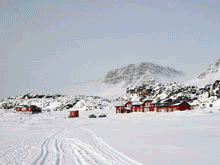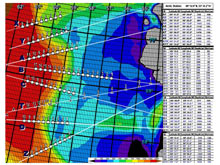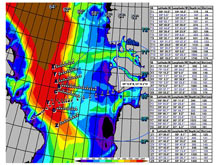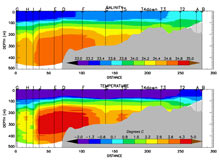
View a slide show of the scientists' activities tracking narwhals along Melville Bay in Northwest Greenland. The scientists tagged narwhals with satellite transmitters to collect oceanographic data in remote Arctic areas.
![]() Click image to view a slide show.
Click image to view a slide show.
Potential oceanographic lines developed for pack ice sampling. Several sites were identified and left as options so that the best possible area could be chosen based on sea ice conditions. Click image for larger view and image credit.
Narwhals as Oceanographers
Mission Summary from Leg II
June 2007
Melville Bay, Northwest Greenland
Dr. Kristin Laidre, Polar Science Center
Applied Physics Lab, University of Washington
Dr. Mads Peter Heide-Jørgensen, Greenland Institute of Natural Resources
Leg 2 of a 2-part expedition (beginning in September 2006) was conducted in the pack ice off the West Greenland coast. In September 2006, scientists from the University of Washington and the Greenland Institute of Natural Resources instrumented 3 narwhals with satellite-linked time-depth-temperature recorders to track whale movements, diving behavior, and ocean temperature structure in Baffin Bay. The narwhal tags collected water column temperature profiles in the pack ice to >1,500 m. The second portion of the expedition, conducted in April 2007 from the town of Qeqertarsuaq, focused on collecting oceanographic data from Baffin Bay which was used to characterize the salinity and temperatures in April and to calibrate whale-based temperature data. Fifteen CTD (Conductivity, Temperature and Depth) casts were made to 500 m depths with a SeaBird 19 CTD through holes bored in the sea ice. Two of these stations were collected from a ship and 13 were collected from a helicopter landing on large and stable ice flows. Oceanographic data clearly demonstrated the warm West Greenland current moving north along the coast, with temperatures above 4oC between 200 and 400 m with a similar increase in salinity (see map 3). A characteristic cold layer <1°C was seen across the surface down to about 100 m at all stations. Concurrent acoustic data from marine mammals were collected at each oceanographic station (species recorded included narwhals, belugas, bowhead whales, ringed seals and bearded seals) totaling approximately 16 hours of Digital Audio Tape (DAT) recordings and 56 hours of sonobuoy (a device used to record sound) recordings.
The results of this effort were the first wintertime recordings of narwhals in the sea ice, together with over 45 hours of bowhead mating songs, never before recorded in the Atlantic sector of the Arctic. The oceanographic stations were also each equipped with satellite transmitters that provide data on the movement of sea ice until it breaks-up.

Close up of all selected potential oceanographic lines. The T-line (1-15) was sampled during this field project. This line has been sampled in summer and fall by NSF-funded investigators but never in the winter, and the area coincides with the locations of diving narwhals. Click image for larger view and image credit.
During the flights, narwhals were isolated in leads from the helicopter and once a stable lead was identified, the helicopter landed within 500 m to 1 km of the lead edge. Whales were observed, filmed, and one whale was tagged with a satellite transmitter. Narwhals have never been observed or studied in their winter habitat in central Baffin Bay due to dense ice cover, offshore location, and logistics, and this project was the first exploration into the possibility of working on this species on their wintering grounds. Overall the study demonstrated that there is great potential to learn about narwhals in the pack ice. Whales often returned to the same lead within 1-2 hours after the helicopter landed and it was possible to get within 4-5 meters of surfacing animals. Adam Ravetch of Arctic Bear Productions collected spectacular first-time footage of narwhals in the pack ice habitat to be used in a film about the species.


















